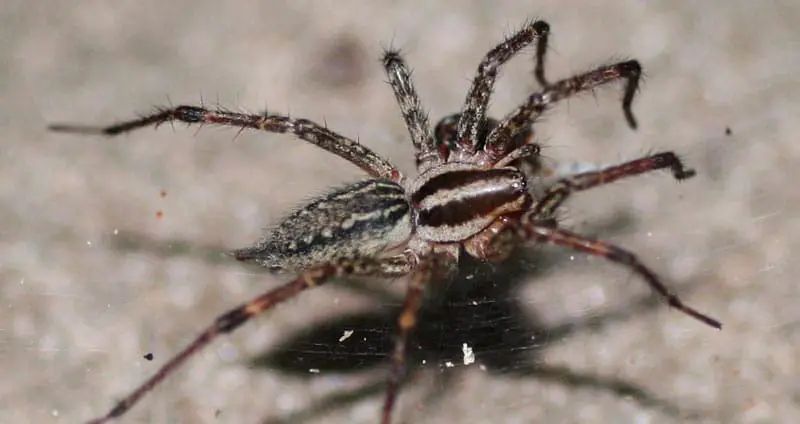No matter where you live, there are some spiders that almost everyone will come across at some point in their lives. If you live in the United States, Canada, or Mexico, the Grass Spider is likely one of those common sightings.
This small and shy spider makes its home in a variety of different environments, but is most commonly found making prominent webs in the grass in your very front lawn.
Often confused with other, more harmful spiders, Grass Spiders are ultimately harmless and may actually be a welcomed guest for some people.
Table of Contents
At A Glance
| Scientific Name | Agelenopsis |
| Distribution | United States, Canada, and Mexico |
| Habitat | Grass, shrubs, trees, and man-made covered areas |
| Size | 3/5″ to 3/4″ |
| Bite | Non-threatening |
| Lifespan | 1 year |
Different Species of Grass Spiders
The name “Grass Spider” actually encompasses several different species of grass spiders, all of which have different distributions and slightly different appearances.
There are currently 14 different species of Grass Spiders, as listed below:
| Agelenopsis actuosa | Agelenopsis aleenae | Agelenopsis aperta |
| Agelenopsis emertoni | Agelenopsis kastoni | Agelenopsis longistyla |
| Agelenopsis naevia | Agelenopsis oklahoma | Agelenopsis oregonensis |
| Agelenopsis pennsylvanica | Agelenopsis potteri | Agelenopsis riechertae |
| Agelenopsis spatula | Agelenopsis utahana |
Grass Spider Appearance & Identification
Grass Spiders are fairly easy to identify, although they do look similar to and are frequently mistaken for both Hobo and Wolf Spiders. Fortunately, they can be identified with a closer observation of their appearance and their behavior.
Adult Grass Spiders can have a body length of up to 3/4″, while males often measure only around 3/5″ or smaller.
In terms of coloration, Grass Spiders are brown overall with lighter legs and darker bodies. Their carapace has two dark brown lines running parallel front to back. The abdomen has an abstract chevron pattern that also runs front to back.
You can tell Grass Spiders apart from Wolf Spiders as their carapace pattern is darker and more defined. Additionally, Wolf Spiders lack the abdominal chevron pattern.
Two other features define spiders from the Agelenopsis genus. First, since they spin such intricate webs, they have very prominent spinnerets (web spinners). Additionally, their eight eyes are arranged into three rows, with two on top, four in the middle, and two on bottom.
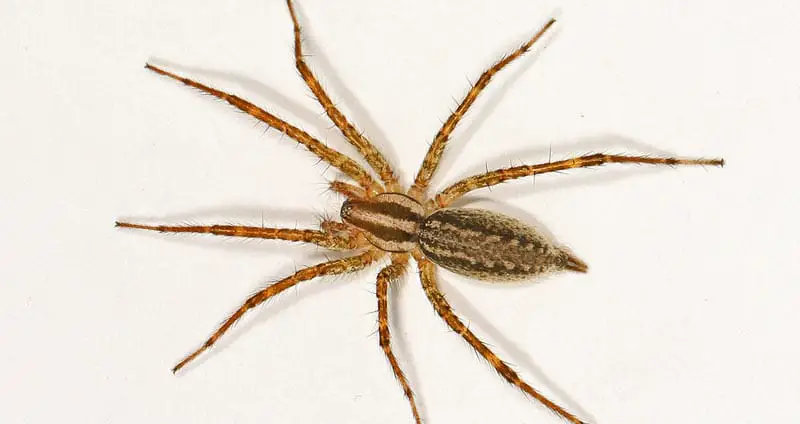
Grass Spider Habitat
As stated, this is a very common spider that can be found in a variety of places. There are species of Grass Spiders that live in every US state in addition to some regions of Canada and Mexico.
In these regions, Grass Spiders stay true to their name and often make their web and home in fields of grass. This can range from tall forest grass to short grass in the front lawns of houses in suburban neighborhoods.
While it seems to prefer grass, it can also make its webs in a variety of different shrubs. It can even find its way inside or around man-made structures and spin their webs there — often near a light source.
So, if you see one or several of these spiders, know that you likely aren’t doing anything wrong. They’re simply very common and take up residence in a wide array of areas.
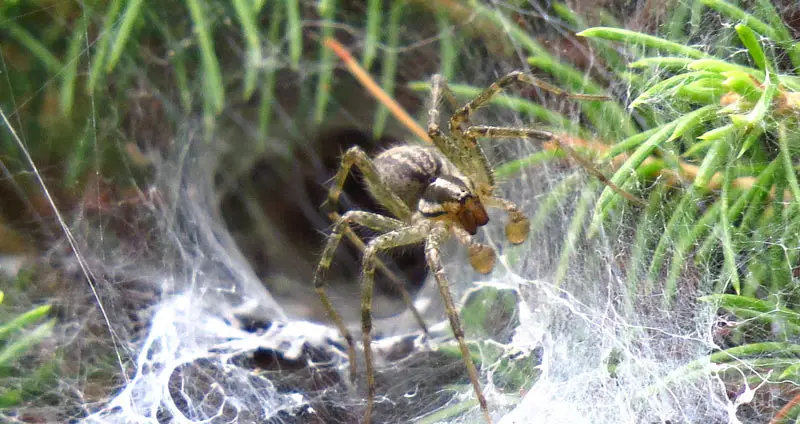
Grass Spider Behavior & Web
The web of the Grass Spider is what makes them easy to identify, as they’re quite unique from the majority of other spiders. Agelenopsis is considered a funnel-weaver genus, meaning that its species weave sheet webs with a funnel shelter on one side.
Most specimens can be found in the back of a cave-like web that they create within grass. This funnel-like design isn’t just for show. It serves two purposes that contribute to the success of this type of spider.
First and foremost, this is an optimal setup for hunting. A Grass Spider’s web isn’t sticky, but it’s very difficult to leave once it’s entered.
When an insect enters the web, the Grass Spider uses its impressive speed to quickly subdue them.
Additionally, the funnel web acts as a great hiding place. As this is an ambush predator, they spend most of their time lying in wait for their next feast.
If it doesn’t make its web in a field of grass, the next best option is in a warm, dry area near a light source that attracts insects.
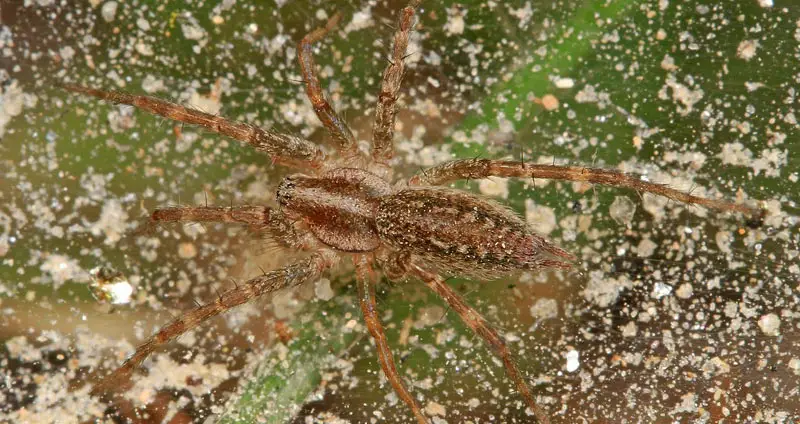
Grass Spider Bite & Venom
Seeing one or several Grass Spiders in your front lawn may seem intimidating, but you don’t have much to fear. These are ultimately harmless spiders that can be left alone to live their lives.
A bite from a Grass Spider does contain venom that it uses to subdue its prey, but this venom is medically insignificant for humans. Most, if not all bite victims only experience mild pain from the bite itself that subsides quickly.
While bites from Grass Spiders can happen, they’re very uncommon. These are skittish spiders that will use their agility to run away from danger as soon as it arises.
One of the only instances where this spider will bite a human is if it’s forced against the skin, such as when it’s hiding in clothing and that clothing is put on.
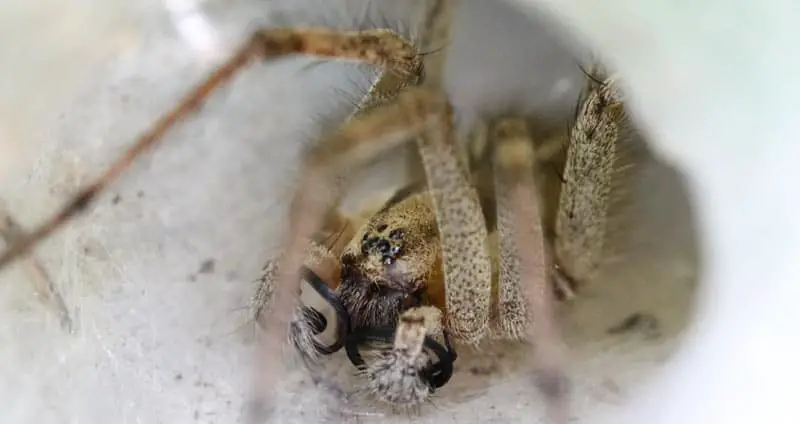
Grass Spider Eggs & Spiderlings
The life cycle of a Grass Spider only lasts for about a year, and both of the main stages prove to be fatal for both sexes.
Mating happens around summertime, and males die very soon after mating season comes to a close. Then, in late summer or early fall, females deposit disc-shaped egg sacs into a crevice.
It’s around this point that the weather gets cooler, killing off the female Grass Spiders. In fact, they can often be seen dead, clinging to their unhatched egg sacs.
While adults die in the winter, their egg sacs overwinter and hatch in the spring.
As these newly-hatched spiderlings don’t have a mother to care for them, they quickly scurry off to build webs of their own and begin the cycle over again.
Random Grass Spider Facts
- The Grass Spider’s genus, Agelenopsis, is a combination of two words: Agelena, referring to Eurasian Grass Spiders, and opsis, a Greek word meaning “to have a similar look”.
- Their webs can span in length from several inches to several feet.
- Grass Spiders were first described in 1869 by C. G. Giebel.
- A Grass Spider’s web acting as a snare instead of being sticky is an uncommon trait.

